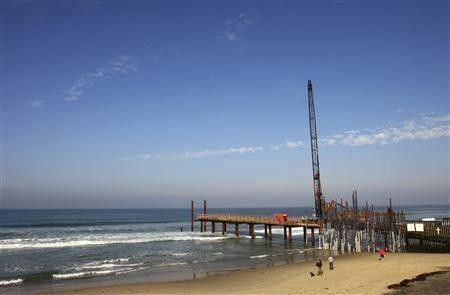U.S. ocean fence aims to curb smuggling from Mexico

U.S. authorities are building a steel and concrete barrier 300 feet out into the Pacific Ocean south of San Diego to curb dangerous attempts by illegal immigrants and smugglers to slip through the breakers to California.
The new maritime fence is being built at a cost of $4.3 million at the point where the U.S.-Mexico border plunges into the ocean between San Diego and the industrial powerhouse of Tijuana, in northwest Mexico.
The new surf fence is a steel-and-concrete barrier up to 18 feet tall that replaces a rusted and uneven line of posts.
It was falling apart, it was out of alignment, it looked like a bad set of teeth, said Customs and Border Protection spokesman Ralph DeSio.
This is going to be much more aesthetically appealing to that area, but it also strengthens our abilities to prevent those dangerous smuggling attempts along that shoreline, he added.
Federal authorities in recent years have added fencing and Border Patrol agents along the southwest border with Mexico in a bid to stop illegal immigrant crossings and drug smuggling to the United States. Congress also mandated building a further 650 miles of fencing along the 2,000-mile border.
Recent attempts to slip north through the surf and inshore waters to Imperial Beach, south of San Diego, have included two smugglers nabbed with marijuana piled onto a surfboard in 2009, and a pair of wetsuit-clad illegal immigrants arrested last February with self-propelled underwater dive scooters.
Illegal immigrants from Mexico have also taken to the sea to swim around the existing rusted barrier and into Border Field State Park in southern California. One man drowned attempting the trip through the frigid waters last November.
The upgrade comes at a time when smugglers are also increasingly pushing further out sea in open-topped panga fishing boats to run illegal immigrants and tons of marijuana up the coast as far as the Los Angeles and Santa Barbara areas. There have been 14 incidents there since last October.
In a bid to make it more resilient to the pounding Pacific waves, the new barrier, which is due for completion in March, is coated with protectants inside and out, and is then being filled with concrete. It has an estimated life of up to 30 years, DeSio said.
The effort under way to ratchet up security at the beach, which includes a stretch of fencing that runs 900 feet inland, is raising some eyebrows in Tijuana.
Policeman Cesar Ochoa is struck by the transformation to Parque Amistad, or Friendship Park, just back from the beach, where families separated by the border would chat informally through the bars of the fence beside a historic monument. A double fence now walls off the area and prevents visitors from getting to within a few feet of each other.
The only thing that remains from that time are the cement tables where people used to meet. There were Border Patrol agents watching over them ... but they let people interact, Ochoa said.
After they started to increase surveillance because there were people who took advantage of those visits to slip into the United States illegally, which I suppose is why they cracked down on security, he added.
Local government employee Adriana Medina, 33, remembers families picnicking and playing ball and even partying in the park when she was growing up and is surprised by the upgrade that pushed steel posts right into the sea.
It looks like a jail, she told Reuters. I think it's an overreaction.
© Copyright Thomson Reuters 2024. All rights reserved.





















